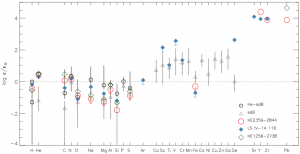
This figure from Naslim N. et al. (2013) shows chemical abundances for several stars relative to the Sun. The compositions for the unusually lead-rich stars are shown as a red circle, blue diamond, and green diamond.
Today in journal club, we discussed two papers.
We started with Schlichting et al. (2013), which looked at the size distribution of Kuiper belt objects (KBOs) to figure out how they formed and evolved over the history of our solar system.
Since, as the paper says, the Kuiper belt “is a remnant from the early solar system”, its size distribution depends on the accretion processes that gave rise to planets and also on the collision processes that affect many aspects of planetary formation and evolution.
KBOs range in size from unobservabley small to about a thousand kilometers (km) in radius (Pluto-sized), but the numbers of objects of a given size depend on how the objects formed and on the nature of the collisions among the objects (which can break up the smallest objects).
Schlichting and colleagues argue that the size distribution of KBOs suggests that smaller objects (less than about 30 km in radius) have been dominated by collisions, while bigger objects are much less affected by collisions. So the bigger objects may provide a glimpse into the early history of our solar system.
The other paper was Naslim N. et al. (2013), which announced the discovery of the most lead-rich stars ever found. The stars discussed in the paper are sub-dwarf stars — essentially very small, retired stars — and have thousands of times more lead in their atmospheres than our Sun.
Not only is the amount of lead surprising, it’s surprising that we can see the lead at all. Since lead is so much heavier than the hydrogen and helium that make up most of the stars’ atmospheres, we would expect the lead to settle out of the atmospheres, deep enough in the star that we couldn’t see it.
However, something has caused the lead in these stars to remain suspended in their atmospheres, but not other heavy elements. The authors suggest preferential radiative levitation (essentially some kind of interaction between the atoms and the stellar light) keeps the lead suspended but not other heavy elements.